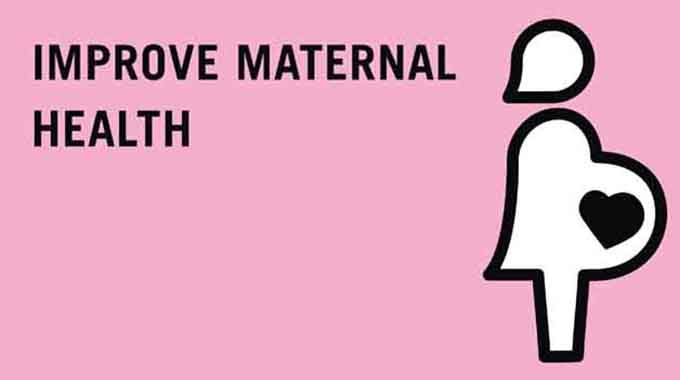Maternal mortality decrease, step in right direction

Roselyne Sachiti Features, Health & Society Editor
Last week, the Zimbabwe National Statistics Agency (ZIMSTAT) disseminated wide-ranging findings from the Multiple Indicator Cluster Survey (MICS 2019).
Notable was the decline in maternal deaths, an indication that the country was taking the right steps to achieve its goals of ending the scourge.
In the latest MICS report, Zimbabwe recorded a decrease in maternal mortality from 614 to 462 maternal deaths per 100 000 live births since 2014, and an increase in full immunisation coverage to 85 percent.
The latest findings echo the country’s commitment made at the International Conference on Population and Development (ICPD25) in Nairobi, Kenya, last year.
At the summit, top on the list of Zimbabwe’s pledges was to halve maternal deaths from 614 to 325 per 100 000 live births by 2030.
Policies and partnerships
This, of course, is a result of Government policies and donor efforts that include the scrapping of maternity fees in public hospitals, the introduction of mothers waiting shelters/homes, free blood coupons, among others.
For example, waiting shelters as an intervention have helped women at most rural health facilities where distribution of healthcare facilities is uneven.
Before the intervention, some rural women found it difficult to access the nearest health facilities because of long distances.
The provision of shelters or maternity waiting homes has helped in decreasing maternal and perinatal mortality by improving access to skilled birth attendance and emergency specialised care, particularly for women in rural areas.
Mothers’ waiting homes also play a critical role in the reduction of maternal mortality as they help curb the three delays, which are delay in decision to seek care; delay in reaching care and delay in receiving adequate healthcare.
In Zimbabwe, most funding of the mothers’ waiting shelters comes from development partners like the United Nations Children’s Fund under programmes like the H4+ and the Health Transition Fund (HTF), and the United Nations Population Fund (UNFPA), among others.
This is done through technical and financial support to the Government through the Ministry of Health and Child Care (MoHCC).
Even with the funding more still needs to be done to ensure sustainability in the event that donors who are contributing to their running pull out.
In Zimbabwe, direct and measurable causes of deaths in pregnancy and childbirth are mainly severe bleeding (mostly after childbirth), infections, high blood pressure during pregnancy (pre-eclampsia and eclampsia). To curb these, Government and its stakeholders have partnered to ensure these are reduced.
For example, United Bulawayo Hospitals which records about 4 756 deliveries annually with a 40 percent C Section rate has benefited from a partnership between the Ministry of Health and UNFPA.
When UNFPA East and Southern Africa Region (UNFPA-ESARO) director Dr Julitta Onabanjo recently toured UBH, gynaecologist Dr Harrison Rambanepasi briefed her that UNFPA provided them with maternity kits, blood and blood products through blood coupons.
However, the Government of Zimbabwe has taken over the funding of blood coupons.
Through UNFPA support, he added, the hospital also received lifesaving maternal health drugs, oxytocin, magnesium and sulphate just to name a few. All these interventions help reduce maternal deaths.
UNFPA has provided funding for the refurbishment of a dilapidated building which will house the obstetrics and gynaecological department at UBH and once completed, a bigger maternity facility will benefit hundreds of women.
When completed, the refurbished building will have two operating rooms, two intensive care units and a 15-bed gynaecological ward.
Additionally, they have supported the training of midwives, nurses, doctors on basic and emergency maternal and neonatal care refresher courses.
They have also supported midwifery institutions and nurse training institutions and provided family planning.
Another intervention introduced to curb maternal deaths is the Government policy that resulted in the scrapping of user fees in public health institutions.
MICS at a glance
The large-scale and challenging field survey was conducted between January and April last year for the 2019 MICS and received funding from the European Union, UKAID, and the Government of Sweden as well as UNICEF and UNFPA. Through these efforts, Zimbabwe became only the 14th country to complete and release the 6th round of MICS results.
The main objectives of the survey are to collect socio-economic data on health, education, child protection, water and sanitation, HIV/AIDS, human capital and well-being of children, women and men of Zimbabwe that can be used for monitoring progress towards achievement of SDGs, Medium Term Plan, ZUNDAF and Transition Funds.
MICS also seeks to build capacity of national partners in data collection, compilation, processing, analysis and reporting on the situation of children, women and men.
This survey also provides decision makers with evidence on the situation of children and women’s rights and other vulnerable groups in Zimbabwe and to produce the multi-dimensional child poverty measurement.
“Though other countries are following, including some in the Southern African region, having Zimbabwe as one of the first few to complete the survey is testament to the value that the Government of Zimbabwe attaches to the importance of robust indicators on the situation of children and women,” said UNICEF Representative Laylee Moshiri last week.
“I am very excited today that we are disseminating the 2019 MICS results. The results could not have come at any better time than now when the Government of Zimbabwe is in the process of coming up with the first Five Year National Development Plan aimed at steering the country towards sustainable development,” she added.
The survey findings provide disaggregated data to measure progress and assess gaps on key indicators in numerous thematic areas affecting women and children’s lives such as child and maternal mortality, fertility, child health and nutrition, amongst many others.
“The MICS are conducted under the auspices of the Zimbabwe United Nations Development Assistance Framework (ZUNDAF) jointly coordinated by the Office of the President and Cabinet and the UN Resident Coordinator,” said Mr Taguma Mahonde, ZIMSTAT Director-General.
“I would like to commend UNICEF for coordinating the provision of financial and technical assistance for the MICS without which this survey would not have been possible. The partnership with the Government of Zimbabwe is appreciated and I hope it will grow from strength to strength,” he said.
Since its inception in 1995, 326 MICS surveys have been conducted by 116 countries generating data on key indicators on the well-being of children and women, and helping shape policies and programmes for the improvement of their lives. MICS is a major source of data for countries to measure progress on the 2030 Agenda and achieving the Sustainable Development Goals.
The MICS involves a wide range of stakeholders at different levels including key Government departments, namely ZIMSTAT, Ministry of Finance and Economic Development, Ministry of Health and Child Care; Ministry of Primary and Secondary Education, and Ministry of Public Service, Labour and Social Welfare.
The latest MICS also carries new topics that include: rapid water quality testing, social transfers, foundational learning skills (children age 7-14), child and adult functioning, migration status, use of clean fuels and technology, and victimisation.
The 2018/19 MICS also provides a wealth of social statistics for the assessment of progress towards achievement of expected social outcomes and impacts for the children, women and men of Zimbabwe as well as for the development of new programmes in 2019.









Comments